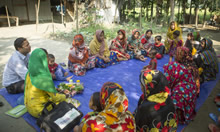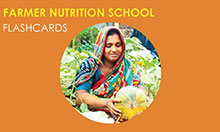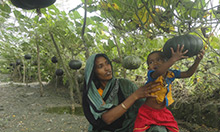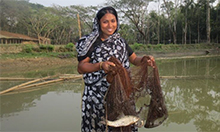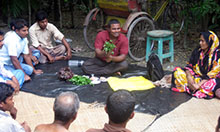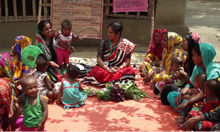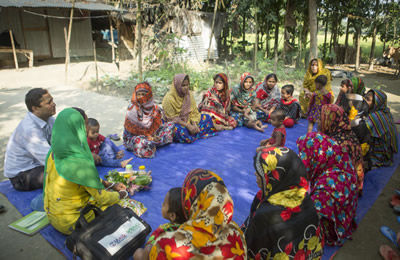
Section 1: Background and Evidence
Introduction to SPRING/Bangladesh
The goal of U. S. Agency for International Development (USAID)-funded Strengthening Partnerships, Results, and Innovations in Nutrition Globally (SPRING) project in Bangladesh is to improve the nutritional status of pregnant and lactating women (PLW) and children under the age of two years in Barisal and Khulna divisions. In pursuit of this goal, the project supports adoption of the Essential Nutrition Actions (ENA) and Essential Hygiene Actions (EHA) and consumption of nutritious and diverse diets through an integrated social and behavior change (SBC) approach.
Operating from 2012 to 2017, SPRING's work in Bangladesh uses the 1,000-day approach and a comprehensive SBC strategy within the health and agriculture sectors to reduce and prevent stunting in young children in 40 upazilas, or sub-districts, in the USAID Feed the Future zones of influence regions of Barisal and Khulna. We work with health and agricultural workers within the Government of Bangladesh and other non-governmental organizations (NGOs) to develop the confidence and capacity to counsel PLW and parents of children under two on nutrition and hygiene at a variety of contact points, from community clinics to households.
Community-based farmer nutrition schools (FNS) promote the production and consumption of nutrient-dense fruits, vegetables, and animal source food at the household level. SPRING/Bangladesh incorporates the promotion and support of ENA/EHA into each session of its three food-production training modules: vegetable gardening, poultry rearing, and fish production. By incorporating ENA and EHA behaviors through small "doable" actions, we ensure that FNS participants receive adequate knowledge to link their food production with improved nutrition and hygiene practices and improve their ability to consume a diversified diet.
SPRING/Bangladesh maximizes resources through collaboration with partners and projects to ensure that nutrition programming reaches the greatest number of people in an efficient and effective way. The project also demonstrates that small innovations are sometimes the most effective. An example of this is SPRING's use of tippy taps and improved hatching pots, or hajols, which we promote during FNS sessions. Finally, SPRING/Bangladesh has shown that handwashing can be a successful component of a community-level nutrition program.
Building Evidence
Farmer field schools and homestead food production are two evidence-informed program approaches that have been widely embraced by development and donor communities around the world. We combined them with an ENA/EHA framework to develop our FNS approach. This section briefly describes each of these "parent approaches."
Farmer Field Schools
Farmer field schools (FFS) were first started around 1989 in Indonesia. The first FFS were designed to educated farmers on the principles of integrated pest management (IPM). In the early 1990s, the United Nation's Food and Agriculture Organization (FAO)'s rice IPM program introduced FFS in Bangladesh (FAO n.d.). Since 1997, Danida, Denmark's international development arm, has supported the scale up and development of this approach in Bangladesh. The FFS is a participatory group training approach that follows the experiential learning cycle for adult education. Farmer field schools build on what farmers already know and use farming activities to demonstrate new, alternate, and sustainable methods. Initially, FFSs focused on rice to promote the use of biological and integrated pest management as an alternative to chemical control, but gradually expanded to other crops, livestock, fisheries, non-agricultural production, general livelihood issues, and environmental management.
As the learning takes place in the field, and the field provides the learning opportunities, the term "farmer field school" was introduced. Although FFS was developed originally to promote better field crop production practices and IPM, SPRING and others have found that the "learning-by-doing" approach is well-suited to a range of home gardening activities, especially incorporation of small-scale vegetable cultivation, native chicken rearing, and fish culture in homestead-based ponds. Typically, a farmer field school takes one to two years to complete.
FFS principals emphasize:
- Farmers: FFS consists of field studies and special topics, based on actual problems identified by farmers.
- Learning: FFS is not top-down technology transfer. The field provides the learning material. Activities continue over a long period of time.
- Group-based discovery: FFS learning takes place in the field by small groups doing comparative studies/experiments (discovery learning). Farmers learn together and from each other.
- Facilitators: FFS requires competent, skilled people to facilitate the learning process; they are not teachers. Facilitators support learning by asking questions. They must have relevant technical knowledge and but not present themselves as experts: the farmers themselves are the experts. A potential facilitator needs good mentoring, on-the-job training, and plenty of experience.
- Empowerment: Farmers make all decisions in FFS by collecting and analyzing data and reaching consensus. Participants are expected to make and learn from mistakes. FFS improves farmers' communication, problem-solving, leadership, and negotiation skills.
- Systems approach: FFS considers the farm and the whole agro-ecosystem in the learning process. Farmer ownership of all levels of the process at all levels is essential for sustainability.
- Community: FFS depends on involvement of individual farmers and the community.
Danida's 2011 evaluation found high statistical significance in food insecurity reduction, from 20 percent before FFS to 11 percent after (Danida 2011). FFS participant focus group discussions in the Danida evaluation also indicated that diets became much richer and more diverse after FFS enrollment. FFS households reduced their vulnerability and increased intake of most food items significantly more than other village households. The FFS approach has also showed women, their husbands, and families that women are capable of producing and contributing to household income and food security, and 'FFS women' become role models for other local farm families in their neighborhoods and for their children thereby boosting women's self-confidence. As such, FFS improves intra-household relations and contributes to increasing gender equality in decision making, at least on 'smaller issues', related to production and income. The Danida evaluation also found that, compared to women from control villages, women from FFS households were far more aware and knowledgeable about nutrition for pregnant women and infants, improved cooking methods, and health in general.
The Regional Fisheries and Livestock Development Component mid-term evaluation data showed that the FFS interventions have a positive effect on women's participation in income-generating activities, family decisions, production decisions, and community activities. FFS increases women's productive role, self-confidence, and status in the family and community. Being a member of a group and having the opportunity to learn is a tremendous and positive experience for (illiterate) rural women.
Homestead Food Production
Homestead food production (HFP) was pioneered in Bangladesh in 1988 by Helen Keller International (HKI) and has since reached more than 5 million people in some of the country's most difficult agro-ecological zones. Today, HFP is implemented in many countries around the world, as an important intervention to improve food security and nutritional status while supporting women's empowerment. The approach helps women and their communities increase food security and improve nutrition through year-round gardens, also known as "kitchen gardens," planted with nutrient-rich fruits and vegetables, and through small farms that raise poultry, fish, and livestock. HFP also empowers women, who are traditionally responsible for the majority of gardening activities, and then enables them to increase control over household resources when this activity becomes more productive.
Like many developing countries, the social mobility of women in Bangladesh is limited by cultural norms. Because HFP primarily targets women, the program includes training on gender equality and equity, household resource management, and marketing. HFP uses nutrition and food production as a way to increase negotiation and communication skills among family members. The program gives women the ability to influence decision making at the household and community levels.
By targeting households with young children, HFP ensures that children have access to the vitamins and minerals essential for full physical and cognitive development. The program also teaches women how to feed their infants and young children, as well as themselves, to achieve optimal health. Across Bangladesh, and through scale-up to other countries in Asia and Africa, HKI's HFP approach has decreased aspects of malnutrition among young children and ensures that mothers have sustained access to the resources needed to care for their families. For example, women's income and nutrition indicators such as dietary diversity, and anemia prevalence in women and children are seen to improve in tandem over the course of programs. An external review described the HFP program, saying that "In addition to improving diet quality, this holistic package of interventions empowers women, households, and communities through economic and social development. It respects local customs and practices and gains longevity in return. It leaves a legacy of knowledge, awareness and understanding with its many partners and beneficiaries (Ianotti et al. 2009)."
A typical homestead food production program runs over a two- (or three) year period. The program is constant and remains fairly intensive throughout the implementation period. An HFP program often involves a number of agricultural inputs, such as poultry sheds, poultry, and other small animals, which are given to the farmers to encourage them to participate in food production activities. It also typically uses a village model farm approach, which focuses on a small number of lead farmers who lead their community during the HFP program and encourage others to keep up the desired practices.
Findings from HKI's HFP programs across Bangladesh illustrate the effectiveness of an HFP package, which includes behavior change communication for nutrition and women's empowerment. For example, HKI's DFID/Shiree-supported Making Markets Work for Women innovation fund program (2009–2012) showed that the percentage of households (total 450) with borderline or poor food consumption scores fell from 100 percent to 4 percent between baseline and endline. Stunting decreased across age groups, most significantly for children who were in utero or conceived during the intervention: for children less than one-year, stunting was 31 percent at baseline and 25 percent at endline; for one-year olds, stunting was 56 percent at baseline and 31 percent at endline; for two-year-olds stunting was 72 percent at baseline and 36 percent at endline; for three-year-olds, stunting was 81 percent at baseline and 66 percent at endline. Households also reported an increase in food sufficiency (defined as three stomach-full meals a day), with an average of 7 months of food sufficiency at baseline and 11.5 months of food sufficiency at endline.
Another study commissioned by HKI shows that HFP fosters social behavior change and improvements in health. It can also create meaningful, long-term sustainable changes in food security. Three years after the program ended, it was found that intervention households were nearly twice as likely (70 percent versus 38 percent in the control group) to consume vegetables and more than three times as likely to practice year-round gardening (50 percent versus 15 percent) (Bushamuka 2005). Further, a meta-analysis of research on HFP conducted in 2009 found statistical significance in the diversification of diet among participating women (Talukder 2009).
There is also important external evidence on HFP, including a report from 2009 (Ianotti et al). "Homestead food production in Bangladesh has shown that dialogue and negotiation with caregivers, households, and communities are more effective at changing behavior than lectures and top-down transfers of knowledge." HFP programming has also "benefitted from adopting a multifaceted, multidisciplinary approach that links agricultural activities to other health and development activities in the community." HFP "inherently emphasizes community participation at all stages of the program." Finally, the "standard but flexible design allows implementing organizations to maintain quality control while also ensuring that programs are responsive to their context."
A 2009 discussion paper by the International Food Policy Research Institute (IFPRI) on HFP programs in Bangladesh showed that year-round production increased from 3 to 33 percent; vegetable varieties produced increased by more than two-fold; and that food quantity nearly tripled (from 46g to 135kg) over three months. It also found that egg consumption increased by 48 percent; small children and mothers increased consumption of dark leafy vegetables three-fold; and that children living in households with developed gardens consume 1.6 times more vegetables than children without such gardens.
The HFP program has a long history of important behavior change in the areas of dietary diversity, food security and women's empowerment. There is internal and external research and evidence that supports the impact and sustainability of the model. The strengths of this model are its focus on rural women, community-based approach, women's empowerment, improved dietary diversity and the fundamental focus on nutrition.
Essential Nutrition Actions and Essential Hygiene Actions
Developed in 1990 and most recently revised in 2013, the Essential Nutrition Actions framework was developed by UNICEF, WHO, and USAID. The ENA is often described as promoting "nutrition through the life cycle" because it encompasses pre-pregnancy through the first 1,000 days of life including: women's nutrition, infant and young child feeding, and micronutrients (CORE Group 2014) (see figure 1). As highlighted throughout the 2013 Lancet Series on Maternal and Child Nutrition, scaling up a targeted set of evidence-based nutrition actions in the first 1,000 days (pregnancy up to two years of age) can significantly reduce stunting and improve survival (Bhutta 2013). Interventions included in the framework are recommended by the WHO and updated periodically to reflect emerging evidence. These cost-effective interventions are recognized to improve physical growth and cognitive development as well as reduce mortality, morbidity, and disability associated with malnutrition (CORE Group 2014; WHO 2013).
ENA is often introduced through a cascade training of community workers, health workers, and other relevant agents and promotes adoption of "small doable actions" by using SBC techniques; primarily, counseling groups of mothers are encouraged and supported in the adoption of the promoted practices. These practices for optimal nutrition, such as exclusive breastfeeding for six months, are reinforced through other channels such as community mobilization events and mass media (CORE Group 2014).
Nutrition-specific interventions are recognized as working best when combined with efforts to reduce infections (WHO 2013). Growing evidence shows that continuous exposure to pathogens can result in gut inflammation and malabsorption of nutrients through a subclinical condition known as tropical or environmental enteric disease, which leads to stunting (Humphrey 2009).
The EHA are specific water, sanitation, and hygiene (WASH) interventions that are critical to decreasing diarrheal episodes resulting from fecal-oral contamination (CORE Group 2015).
Figure 1. The ENA/EHA Life Cycle Approach
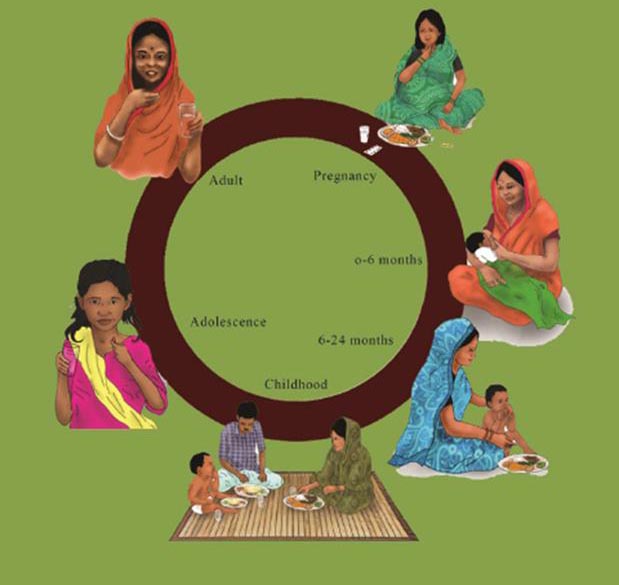
Section 2: Farmer Nutrition Schools – Evidence from Bangladesh
The evidence on the impact of FFS and HFP is indisputable. It was clear, however, that there were areas needing improvement and overlooked opportunities to apply these approaches to improve nutrition outcomes. For example, while FFS has an excellent methodological approach for community mobilization and behavior change, it does not focus on women or nutrition as a central part of its mandate; instead, it tends to focus on income generating activities. Similarly, although the HFP approach has excellent demonstrated results for food and nutrition security, its focus on demonstration plots and extensive training requires more time and resources. There are many areas of overlap between the two programs, which are compatible in many ways—the intention here is not to say that one is better or worse.
SPRING/Bangladesh sought to learn from both of these models and to bring them together in a way that could work at scale while also promoting ENA/EHA. Bringing two comprehensive models together, however, meant needing to focus on specific areas and a few aspects of each model. Further, due to donor requirements and funding constraints, a faster, more affordable model was needed. SPRING's merging of two evidence-based implementation approaches has, over the past five years, established an identity of its own: the Farmer Nutrition School.
FNS takes the learning-by-doing or discovery approach of FFS and merges it with the smaller-scale, household-based approach used in HFP programs. The critical difference between FNS and other adaptations of the FFS model is that it is designed around a core of 1,000 days nutrition and hygiene messages that focus on improving diets through consumption of food produced at the household level.
Applying the Agriculture Nutrition Framework
The success of SPRING/Bangladesh can also be measured against how well the program has applied the programming principles for improving nutrition through agriculture. We know that agriculture has a clear role in nutrition in the sense that the food we consume translates to calories, fat, protein, and micronutrients. But agriculture affects nutrition in less obvious ways, such as the influence it has on income and gender roles. SPRING uses the agriculture and nutrition (ag-nut) pathways, first developed by Anna Herforth, as a framework to see how household assets and livelihoods lead to nutritional outcomes. The agriculture-nutrition pathways improve nutritional outcomes and help ensure that Feed the Future's nutrition goals are met. The pathways help illustrate—
- how various agriculture investments or activities could improve access to food and health care
- how they impact and are affected by the enabling environment
- how they affect the nutrition of individual women and children.
The figure below highlights the pathways in which FNS contributes to nutrition.
Figure 2. The Ag-Nut Pathways for SPRING/Bangladesh's Farmer Nutrition Schools
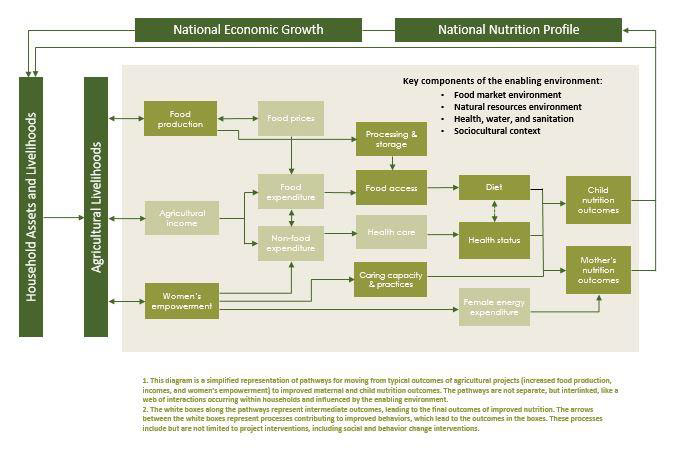
There are three main paths through which this happens: food production, agricultural income, and women's empowerment. Using the food production and women's empowerment pathways, we have identified how our FNS approach leads to improved nutrition, as follows:
1. Incorporate explicit nutrition objectives and indicators into their design, and track and mitigate potential harms while seeking synergies with economic, social, and environmental objectives.
The ultimate goal of FNS is improved nutrition, and the FNS approach uses food production to improve dietary practices and nutrition and hygiene. The underlying objective of FNS is to increase the consumption of a more diverse diet, especially for PLWs and children under 2 years of age.
FNS tracks progress related to behavior change on dietary diversity, minimum acceptable diet, consumption of animal-source foods, and handwashing behaviors, among other components. It also seeks to mitigate harm by focusing on safe food production and preparation practices and issues surrounding biosecurity. In contrast, a purely agricultural production-focused FFS primarily tracks progress in increasing the volume and quality of crops and animals, rather than household consumption and dietary diversity. Over the five years (2012–2017) during which we implemented our FNS program in Bangladesh, we found through a cohort study that dietary patterns of women and children significantly improved. Women's dietary diversity score, for example, increased from 3.9 food groups before women were introduced to FNS, and jumped to 6.0 groups after the nine-month training period. Dietary diversity remained high at 5.6 groups even one year after we finished our intervention1. Other research clearly indicated the wide acceptability of the program, the extensive spillover effect in the community, and huge gains in both knowledge and practice for improved nutrition at the household level.
Figure 3. Graph: Change in Dietary Diversity Scores among FNS Members from P1 (before FNS started), to P2 (after the 18 FNS sessions) and P3 (one year after the completion of FNS) from SPRING's Cohort Study
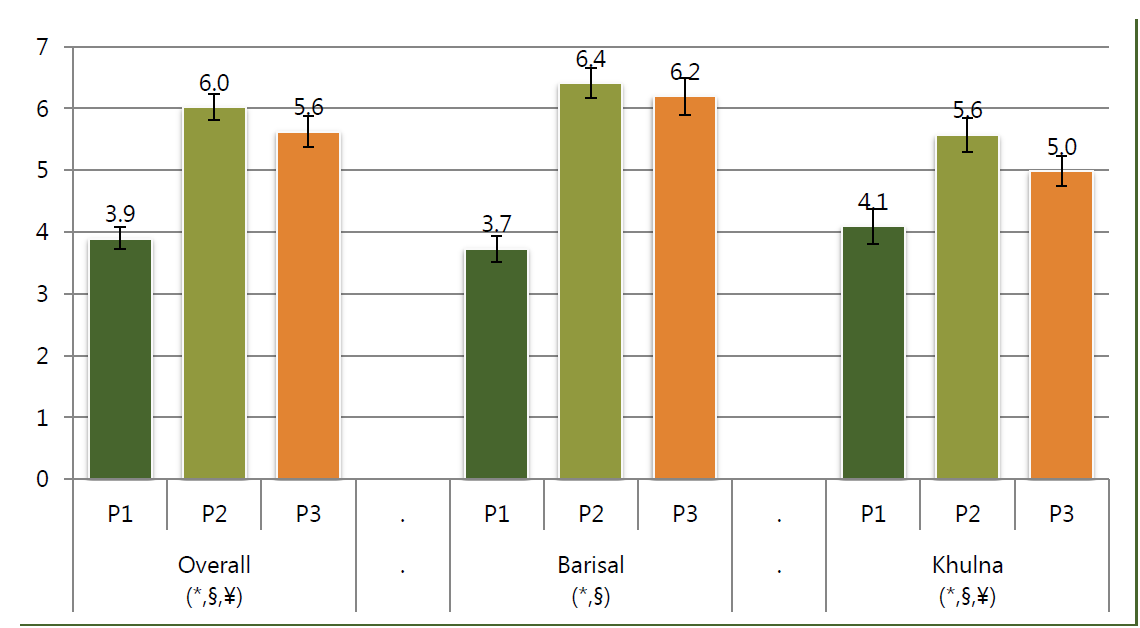
2. Assess context at the local level to design activities that address the types and causes of malnutrition.
SPRING used Food Security and Nutrition Surveillance Project (local nutrition survey) data and other data available through USAID and UN partners to assess the nutritional context in its working areas. It was clear that dietary diversity, exclusive breastfeeding, complementary feeding, and handwashing were areas that needed special attention. We designed interventions to achieve sustained behavior change in these areas, especially household-level food consumption.
The program selected foods that were native to the local diet and high in micronutrients. These were foods that vulnerable households could not afford to buy in local markets. Although fish is a staple and many households have backyard ponds, many were underutilized and had low productivity. Likewise, there were limited quantities of eggs available from backyard poultry, and the meager quantities were often reserved for males in the household. The majority of poor households did not maintain home gardens. SPRING helped these household use existing resources and maximize the output and yield using simple innovations to improve food production. Although we did not assess the food market/income generation potential when the FNS program was designed, it could be considered in other iterations of the model. SPRING's results in Bangladesh showed that graduated FNS participants have expanded production and profited from their intensified efforts. We also found through our cohort research that food production practices increased dramatically for vegetable gardening, chicken rearing, and fish cultivation.
3. Target the vulnerable and improve equity through participation, access to resources, and decent employment.
We focused on the 40 percent poorest households (two poorest wealth quintiles) in our working areas. The focus on the lower quintiles ensures that the most vulnerable people are gaining the skills to take control of their own health and nutrition.
SPRING emphasized simple, low- or no-cost solutions that build on the existing resources of vulnerable households, however meager. We focused on the homestead (less than half a decimal of land) rather than the field, to ensure control by women of the household. Geographic clusters of 20 women were targeted and encouraged to form an FNS that is time-accessible to all.
FNS provides simple lessons to help women better maintain food security, ensure that their families get nutritious food, and generate income from their excess production. Women's empowerment resulting from the program has been proven through FFS studies in the literature. SPRING's endline research has shown that measures of food security, including household hunger scores, food running out, and food consumption scores all had a major improvement in SPRING households with statistically significant results. For example, food ran out in only 17 percent of the SPRING households at endline, as opposed to 66 percent before SPRING started its FNS work.
4. Collaborate and coordinate with other sectors (health, environment, social protection, labor, water and sanitation, education, energy) and programs through joint strategies with common goals, to address concurrently the multiple underlying causes of malnutrition.
The FNS approach is highly integrated, incorporating lessons on health, environment, water and sanitation, time management and, of course, agriculture, in that each of the 18 FNS sessions incorporates components of these areas into its lessons. This multifaceted approach targets both underlying and direct causes of malnutrition. At the end of the FNS sessions, one woman is selected to serve as a Community Nutrition Champion in her community. SPRING/Bangladesh also found ways to link these community nutrition champions from each of the graduated FNS with the frontline GOB-run health facilities. This connection helps forge deeper and more sustainable linkages between the communities and the health facilities. More than one-fourth of the more than 6,000 women who were enrolled as community nutrition champions have been involved in the government health system, which strengthened ties between the community and the frontline health facilities and empowered women from these communities to speak out for maternal and child health and nutrition.
Figure 4. Number of Community Clinics (CC) Supported by SPRING and the Corresponding Number of Community Nutrition Champions (CNC) Who Support the Community Groups (CG) and Community Support Groups (CSG).
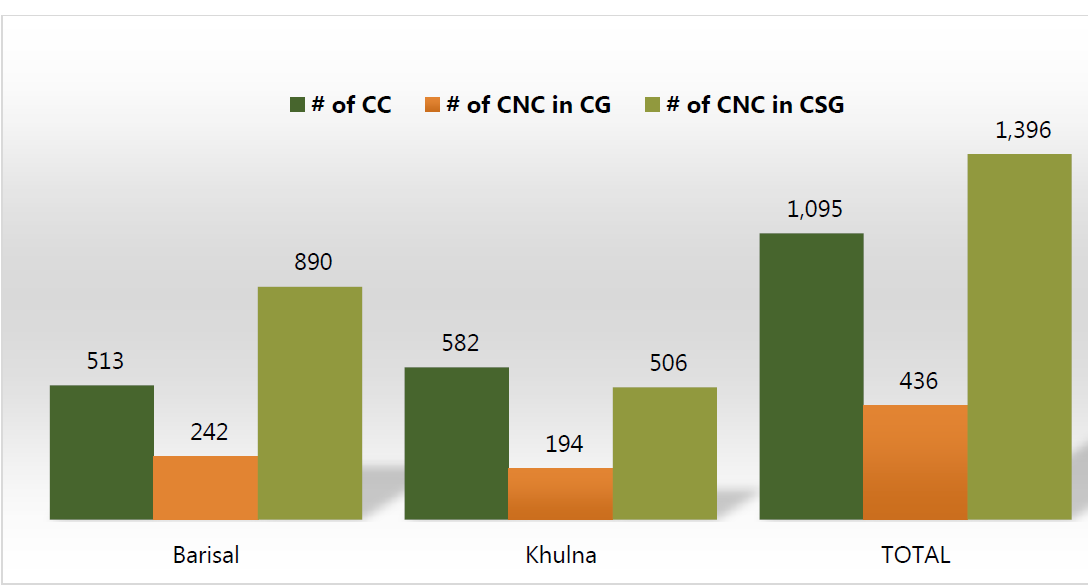
Over time, we made important decisions and adaptations at the community level to find better ways to involve the broader community, including inviting mothers-in-law as proxy members, involving husbands and fathers-in-law, and introducing and closing FNS sessions with community-wide events to reach as many community members as possible.
5. Maintain or improve the natural resource base (water, soil, air, climate, biodiversity), which is critical to the livelihoods and resilience of vulnerable farmers and to food and nutrition security for all. Manage water resources in particular to reduce vector-borne illness and ensure sustainable, safe household water sources.
Biosecurity and hygiene are important components of the FNS curriculum. Considerable time is spent discussing the risk of using pesticides, not only their hazards to food safety but also their negative environmental impact. The agricultural practices promoted by FNS, such as water conservation, composting, mulching, and use of open pollinated seeds and safe water sources focus on improving and sustaining availability of and access to safe and nutritious foods for the entire household.
6. Empower women by ensuring access to productive resources, income opportunities, extension services and information, credit, labor and time-saving technologies, and supporting their voice in household and farming decisions. Equitable opportunities to earn and learn should be compatible with safe pregnancy and young child feeding.
FNS also contributes to women's empowerment by giving women the knowledge and skills to take improve their family's diet and better manage basic health and hygiene issues. In doing so, women gain time and energy to better care for themselves, which elevates the health and nutrition status of mothers and children community-wide and beyond.
FNS promotes a whole-household approach so that male and female family members— not just female— are responsible for ensuring food and nutrition security. When husbands and other men in the household are involved in home-based food production activities and looking after children. When household chores and caregiving duties are shared, women have more time and energy for taking care of themselves during pregnancy and for their infants and young children. SPRING used the IFPRI=abbreviated Women's Empowerment in Agriculture Index (WEAI) tool to assess the extent to which women who participated in SPRING's FNS were empowered. The results of the study showed that, as compared to similar households that did not participate in an FNS, SPRING women scored better (a score of .75 compared to a score of .62) in the five domains of empowerment and enjoyed greater gender parity with the male head of their households.
By focusing on homestead food production and not field crops, women are ensured control of productive resources. Forming a supportive and reinforcing cluster of 20 women to form an FNS also ensures that extension services and information are accessible to women. In its recent program evaluation, Danida demonstrated the positive impact of the FFS methodology on women's empowerment. SPRING/Bangladesh believes that since the FNS program was built on the essentials of these two successful programs (FFS and HFP), the FNS program could also have an impact on women's empowerment.
7. Facilitate production diversification and increase production of nutrient-dense crops and livestock (e.g., horticultural products, legumes, livestock and fish at a small scale, underutilized crops, and biofortified crops). Diversified production systems help vulnerable producers to enable resilience to climate and price shocks, consume more diverse foods, reduce seasonal food and income fluctuations, and generate more (and more gender-equitable) income.
A major focus of FNS is food diversification and increased year-round production of nutrient-dense crops and small-scale fish and livestock products. We promote mulching, crop rotation, seed preservation, and other technologies to ensure increased year-round production of nutrient-dense crops. The project selected horticultural seeds that provide important nutrients and dietary diversity, and are culturally appropriate and consistent with local eating practices and norms (i.e., familiar foods). Our cohort study found that food production was significantly diversified as a result of FNS: the mean number of vegetables increased from three to more than five varieties and the mean number of chickens increased from 7.4 to more than 10.
8. Improve processing, storage, and preservation to retain nutritional value, shelf life, and food safety; reduce seasonality of food insecurity and post-harvest losses; and make healthy foods easy to prepare.
FNS promotes crops that are not traditionally processed, stored or preserved. In Bangladesh, most foods at the household level are consumed immediately after harvest, so the FNS focused on year-round production and access to diverse, safe, and nutrient-rich foods; mainly 'kitchen garden' crops and animal-source foods that are meant to be consumed immediately. At the same time, the project taught participants how to preserve seeds for year-round vegetable production for food security and provided information on hygienic food preparation to ensure the highest possible degree of safe and healthy foods.
9. Expand markets and market access for vulnerable groups, particularly for nutritious foods and products that vulnerable groups have a comparative advantage in producing. These products include much of the food production in which FNS women take part. This can include innovative promotion (such as marketing based on nutrient content), value addition, access to price information, and farmer associations.
Expanding markets and marketing nutritious foods can be phased in after sufficient 'best practices' have been ingrained and become second nature to participants, and when production reaches significant and viable quantities. A step-wise approach prevents overwhelming the participation of vulnerable households, who have very little to begin with and have never produced for local markets. Further, as a nutrition project, sustained behavior change for health and nutrition is placed ahead of the motive to generate income.
Regardless, by participating in FNS and the mutual support system it engenders, vulnerable women in FNS gain access to innovative food production practices, price information, and farmer associations, and in time may graduate to building and expanding markets for nutritious foods and food products.
10. Incorporate nutrition promotion and education about food and sustainable food systems that build on existing local knowledge, attitudes, and practices. Nutrition knowledge can enhance production and income in rural households, which is especially important for women and young children, and can increase demand for nutritious foods in the general population.
We tailored the FNS curriculum to the rural Bangladesh context. It incorporated local practices, eating habits, familiar foods, and other specific health and nutrition issues. It also dispelled common myths about health and diet that are, again, specific to Bangladesh. This helped populations change behavior to improve consumption of a more diverse and healthier diet.
SPRING/Bangladesh reinforced nutrition knowledge delivered by FNS through a multi-channel approach that incorporated key and complementary nutrition messages in interventions at community clinics and through the agricultural extension system, the latter reaching male farmer groups. This 'message saturation' reached multiple household members at the same time. Our cohort study found that knowledge about nutrition and food practices improved as a result of exposure to the FNS curriculum, with knowledge on child feeding and women's health improving from a low of 53 percent to more than 90 percent.
SPRING/Bangladesh was designed before the release of information on more recent studies and the development of the primary pathways to improving agriculture through nutrition – production, income, and women's empowerment. However, a retrofit analysis easily shows that the program focused primarily on the production pathway by increasing availability of and access to nutrient-dense foods and developing strong social and organizational networks that can continue support for program activities.
If SPRING were to start a new batch of FNS, it would be worthwhile to contextualize and enhance the FNS model in program design in the new working area. Specifically, we would need to understand the agro-ecological environment and holistic livelihoods of the target population, as well as the availability and access of nutrition-sensitive and -specific services. Using this information, we would apply the primary pathways lens, focusing on food production, income, and women's empowerment, to design nutrition-sensitive and -specific interventions.
Key Elements of FNS
We wanted FNS to be anchored in a strong nutrition platform. SPRING ensured that each module of the curriculum started and ended with nutrition and hygiene messages. The project also dedicated three specific lessons to aspects of ENA/EHA. The FNS curriculum was designed to incorporate ENA throughout the three training modules, with topical areas linked back to the importance of nutrition. Each module also included an ENA-specific review session to ensure concepts were understood, their importance internalized, and that women felt empowered to make small changes to improve the nutrition of their children and themselves. In more agriculture-focused sections of the curriculum, we identified opportunities to link agricultural messages to human health and nutrition.
FNS focuses on maximizing available resources instead of providing a lot of inputs, thereby promoting cost efficiency within the model. By designing an 18-session, 9-month curriculum, we streamlined the amount of time needed to implement the program. Finally, through constructed monitoring tools and an innovative approach to sustainability, as described in greater detail below, SPRING/Bangladesh found ways to measure progress and longer term change. In summary, FNS requires less time for implementation (only nine months as opposed to two years) and fewer resources or inputs (only seeds are given) than the HFP or FFS approaches, yet has the same ability to improve long-term behavior change for consumption of a diverse diet and improved nutrition and hygiene practices.
SPRING promotes many of the Essential Hygiene Actions within farmer nutrition schools, such as handwashing. FNS members are taught to construct tippy taps—free, water-saving devices—near their kitchens and latrines. FNS members also learn about biosecurity, including the importance of vaccinating poultry, washing hands after handling animals, and keeping chickens outside sleeping quarters (in a coop or elsewhere on the homestead). SPRING also promotes keeping the homestead free of feces, both human and animal, so children are kept in environments free of contamination.
At the beginning of a new FNS group, a community-wide "celebration" is organized to allow all members of the community to meet and understand what the FNS participants will be learning about. Further, at the end of the 18 sessions, a Pushti Mela (nutrition fair) is held in which the women are awarded for their efforts and the community at large can see the fruits of their labor. Throughout the nine months, there were other national campaigns and events that SPRING helped organize with the Government of Bangladesh and other NGOs. We encouraged the whole community to participate in these activities.
SPRING developed specific 'key elements' or fundamentals that make farmer nutrition schools unique. They are not dissimilar from components used in HFP and FFS programs; these elements, however, are generally not used together in a single program. The combination of these key elements is what makes the FNS approach innovative.
Table 1. Key Elements of FNS
| Key element | Notes |
|---|---|
| Learning by doing | Focus on skills building – more dynamic learning style |
| Minimal inputs | Focus on skills building instead of incentives |
| No-cost/low-cost solutions | Simple, sustainable approaches |
| Year-round production of diversified foods, including animal-source food | Food and nutrition security |
| Consistent and repeated messaging | Reinforcement of ideas for behavior change |
| Simple, evidence-based innovations | Simple, sustainable approaches |
| Whole-family approach | Responsibility of all, greater buy-in, better chance for success |
| Proper enrollment and orientation for participants | Mindset should be clear and expectations realistic to avoid confusion or misunderstanding |
| Clear guidelines and fixed curriculum | Well-trained staff for consistent and clear messaging |
| Regular, comprehensive, and season-based lessons | Make lessons relevant, useful, and routine to ensure greatest possible impact |
| Trained cadre of staff to train and support | Important for scale-up of project |
a. Learning by doing
One of the great elements of the farmer field school approach is the experiential, learning-by-doing approach. As the famous saying goes, "I hear and I forget. I see and I remember. I do and I understand." While many specialists may not agree that seeing will lead to remembering, in the world of social behavior change, it is important to find ways to not only concretize learning but to ensure that the knowledge translates into practice. SPRING wants FNS participants to remember and understand the important nutrition messages that are being promoted so that they can use the agricultural techniques to improve household nutrition.
b. Minimal inputs
Unless you are dealing with the "hard core" poor, it is important that the approach to inputs are carefully mitigated. Many international NGOs provide inputs regardless of the need of the family or household, to encourage people to participate and to get programs going. This can transform the relationship between the community and the NGO into one of dependence. The SPRING approach focused instead on fostering an environment of independence and self-reliance, skills building, and peer-to-peer support mechanisms. There are no cash, in-kind, or other financial incentives in FNS. We are clear from the start that the only "input" we provide will be seeds to get their gardens started; knowledge and skills are what participants will gain.
c. No-cost/low-cost solutions
One of the most important points of farmer nutrition schools is that there is no monetary incentive. The program focuses on what participants can do with what they have. No- or low-cost solutions are introduced to promote long-term, sustainable behavior change for improved nutrition outcomes. New methods and technologies are easy to use, practical, and maximize the resources around them. This approach is best exemplified by tippy taps, which are simple and cost-effective handwashing stations set up near cooking areas and latrines. The only materials needed to build a tippy tap are a plastic bottle, a nail or a small knife, a candle, matches, soap, and rope or string. They are convenient access points for water and visual reminders to wash hands at crucial times. SPRING/Bangladesh encouraged families to wash their hands with soap after defecation and before handling food, eating, and feeding a child.
d. Year-round access to nutritious foods
Knowing what nutritious foods are is enough of a challenge, but having access, much less year-round, is a much greater challenge. By providing FNS participants with important knowledge of year-round gardening practices, families can plan and cultivate a homestead garden that provides nutritious food for the family for most of the year. FNS also shows participants the best ways to preserve seeds and rotate crops.
e. Consistent and repeated messaging
Behavior change requires a certain amount of reinforcement so it is important that participants hear the same messages again and again. It is also important that the messages are consistent in the way they are delivered to avoid any misunderstanding. It is this combination of consistency and repetition that helps ensure that the key nutrition and hygiene messages being promoted are internalized and become common practice for the participants.
f. Simple, evidence-based innovations
In line with no cost/low cost solutions, FNS promotes simple innovations that are easy to replicate and of little or no cost to participants. The easier an activity is to do and replicate, the better chance it will have of working. The tippy tap and hajol (improved hatching pot for chickens) are two examples of simple evidence-based innovations from the FNS program in Bangladesh.
g. Whole-family approach
Although the mother is usually the primary caregiver in a family with young children, her influence and 'say' in how to raise the children and what to feed them are often impeded by the husband or mother-in-law. This is particularly true in Bangladesh, where wives normally move into the husband's home and spend most of their time with the mother-in-law. The power dynamics and influence between these two women cannot be understated and are crucial to reducing rural malnutrition in a rural context, especially in a country such as Bangladesh. By encouraging ways to involve all members of the family to participate in various ways in the FNS, SPRING is able to involve and engage those members of the family that might otherwise impede successful implementation of the program by encouraging them to participate in various FNS activities, such as listening to FNS lessons, and attending sessions when the mother was unwell or unable to attend a session, the family member can serve as a proxy. All of these approaches also helped ensure community-wide buy-in and a more holistic, successful program.
h. Proper enrollment and orientation of participants
Asking a woman to participate is not enough. If she joins the FNS with the wrong idea about the program or has different expectations, it can create misunderstanding, disappointment, and even conflict within her household. It is important that the program carefully orient new participants and their families to ensure that they understand what inputs (if any) will be provided and what their responsibilities will be. Firmly established expectations provide greater benefits and better participation later. As described above, many opportunities are given to sensitize the community to the specific actions and behaviors SPRING is looking to promote and encourages the involvement of other community and family members in the program. This can help ensure that there is less suspicion and more of an embrace of the program from the husband and mother-in-law, who might otherwise prevent the mother from participating and attending.
i. Clear guidelines and fixed curriculum
We spent more than four years fine-tuning and adapting our FNS session guide. SPRING learned that materials should be consistent in content and used according to clear guidelines. This requires an established curriculum.
j. Regular, comprehensive, and season-based sessions
It is important to be careful about the amount of time that a program requires of rural women. Women in most rural contexts have a tremendous workload. It is therefore irresponsible for a program to use too much of their time or in a way that does not contribute to their development and priorities. Comprehensive sessions should take place regularly but should not overwhelm participants. We found that fortnightly sessions worked well. It is important that sessions are relevant to the time of year and the seasonality of crops.
k. Trained cadre of staff to train and support
The FNS model can be scaled up and used to reach a large number of people, but requires a trained cadre of staff. Deep understanding of the concepts is not required to participate in the five-day training, which prepares attendees to start leading trainings themselves. SPRING/Bangladesh worked with several local NGOs to help with the field-level implementation of FNS, which built local capacity and helped overcome the logistical challenges of working at scale, in terms of both numbers of participants and geographic coverage.
The Lancet series of 2008 and 2013 provide an important rationale for strengthening linkages between agriculture and nutrition. "Availability and access to nutritious food can accelerate reductions in stunting" (Bloem 2013). Further, there is evidence showing that high dietary diversity is associated with a 15 percent and 26 percent reduced odds ratio of being stunted among children aged 6–11 and 12–23 months, respectively (Rah 2010).
Monitoring and Evaluation
The SPRING monitoring and evaluation (M&E) team developed a number of tools to help the program ensure participant attendance, analyze data, prepare reports, evaluate the performance of upazila coordinators (UCs) and union-level facilitators (UFs) who conduct the sessions, and learn from experiences. Furthermore, program staff generated reports that contributed to transparency and accountability and allowed for lessons to be shared more easily. Monitoring and evaluation efforts addressed challenges faced and offered a path for learning and future improvements.
Section 3: Considerations for Adaptation
As documented by our various research initiatives, our experience in Bangladesh has shown that the FNS approach can be scaled up and used to achieve sustained behavior change for improved practices in nutrition, hygiene, and food production. This section provides a simple overview of basic considerations that organizations and projects interested in trying the FNS approach in their area should consider.
Reaching the Nutritionally Vulnerable Population: Structure and Composition of FNS Groups
The FNS intervention is intended to reach the most nutritionally vulnerable, e.g., the 1000-days households, PLW, and children under two years of age. Depending on the context, these households can be reached through varying strategies. Elements to consider when looking at strategies include existing farming practices, and social and cultural norms, especially regarding gender, access to information, and the systems and services that can support the groups. In addition to targeting and engaging PLW and women with children under two in mutual support groups, the project identified female participants who already have plots in community gardens to be members and leaders.2 Other considerations included temporary migration of household members (often youth and women of reproductive age), and the practice of passing responsibility for cultivation to other household members, such as grandmothers or siblings, male participation, and cultural practices that require women to be accompanied by men. Through our research using the WEAI tool, we learned that our model also strengthened women's empowerment by encouraging women's participation in a mutual support group and employing a whole-household approach that emphasizes shared responsibilities among male and female household members. There is also evidence of "self-scaling," e.g., FNS leaders reaching out on their own accord, and people joining FNS groups, indicating growing demand for the nutrition-sensitive and -specific services offered by the program. By targeting the most nutritionally vulnerable groups, PLW with children under two years of age, and within that group the most economically vulnerable, the program catered to the specific needs of that population.
Looking at Agricultural Livelihoods through the Production, Income, and Women's Empowerment Pathways
Many agriculture and food security projects that integrate nutrition have focused on small-scale vegetable gardening, cooking demonstrations, and integrating nutrition training into public extension services. Evidence shows that these projects can increase knowledge and dietary diversity; but challenges remain, as these projects on their own have not reduced chronic undernutrition. So while small-scale gardening does play a key role, it is just one element of what is needed to deeply impact food systems. Application of the agriculture to nutrition pathways to FNS may make the model more comprehensive, linking nutritionally vulnerable households to food systems that might better contribute to nutrition outcomes (Herforth 2014).
a. Production pathway
While the approach of integrating nutrition-sensitive agriculture and nutrition-specific messages and practices into a farmer-field school type approach is used in many projects, the context for applying the key elements of FNS will vary. The context analysis of the agro-ecological environment, farm size, cropping systems, extension services, and cultural norms and practices will inform how to support the FNS leaders and groups and how to tailor the project design to the local context. Key issues in the production pathway will include analysis and seasonality of nutrient-dense and cash crops, wild foods, and tree crops (grown and available), and how to improve the supply and demand for these crops. Equally important is the availability and affordability of inputs, investing in seed systems and increasing availability and access of seeds, and generating demand for improved seeds.
In addition to promoting nutrient-rich foods, the FNS model can help farmers identify less obvious nutrition-sensitive practices within the production pathway that affect the sanitary environment and women's time and ability to care for themselves and children. This analysis should include community and group mobilization; decisions on land allocation, access, and preparation; crop choice; water management and WASH practices in an agricultural setting; soil fertility practices; use of pesticides; access to improved technologies and more efficient labor; and post-harvest processing and storage. Another key aspect is access to extension services and information.
COMMUNITY NUTRITION CHAMPIONS
SPRING's Community Nutrition Champions (CNCs) are helping reach more community members and are further empowering rural women by linking them to the civic sphere.
After the completion of the 18 FNS sessions, the group of women selects at least one woman to serve as its CNC, which is a non-remunerated/voluntary position. The role of the CNC is to keep the motivation for nutrition alive and strong, help pregnant and lactating women in her community remember actions and behaviors for nutrition, and link the community to extension services, especially health. SPRING has established more than 6,000 of these female nutrition champions in its 40 upazilas. Thanks to SPRING's initiatives and their passion to help their communities, nearly one-third of them are also involved in their local health systems.
b. Income pathway
We can also expand the FNS model to address key elements that influence the income pathway. Focus groups discussions and analysis of revenue cycles throughout the year can reveal periods when income is available and how it is spent, saved, and reinvested. This analysis could also help households understand how decisions about investments in food, health, and care are made by women, men, or jointly. It could help describe how markets and market prices might better contribute to nutrition outcomes. For project managers, this analysis could guide the development of do-able practices and messages, and the timing of key SBC activities.
Depending on the livelihoods and capacity of target FNS group members, the FNS model could be expanded to link producers to each other and strengthen markets for nutrient-dense foods. However, since farm households produce crops for cash and consumption and have other livelihood activities, projects should integrate strategies for FNS groups to increase and diversify income, while influencing how income is spent on WASH, health, and other services that may influence nutrition. Other components that might be included in the FNS model are tools for household and farm budgeting and providing links to savings groups and other financial services.
c. Women's empowerment pathway
As noted, FNS comprises two approaches, FFS and HFS, which have demonstrated positive outcomes for women. The women's empowerment pathway is highly integrated with both the production and income pathways. In particular, FNS can incorporate considerations of women's time and equitable labor distribution, household decision making, and management of income into its activities. FNS should maintain focus on how women might continue to gain access to and control over assets, strengthening their roles related to decision making within their households while also including men, mothers-in-law, and other influential people within the communities. It is also critical to undertake gender analyses as part of the FNS design, because gender barriers and norms can vary significantly, even within different regions of one country.
Agricultural interventions tend to increase workload (IFPRI time-use discussion paper), and therefore promotion of labor-saving technologies, increased labor efficiency, and equitable labor distribution between women and men are key practices to integrate into the model. Both positive and potential negative impacts of targeting nutritionally vulnerable women must be considered so that strategies to mitigate or prevent these effects can be included. It is also important to ensure there are links to services that support the critical ENA and EHA practices during the 1,000 days.
Scalability and Sustainability
Key considerations for reaching scale and sustainability should be planned and include an assessment of the capacity and motivation of all related service providers (whether public or private). Assessment results can inform which strategies are most likely to help project services continue. For example, Bangladesh has population density, low cost of labor, and many local NGOs available to assist in implementation. In this context, the project can rely on a large number of people and organizations providing low-cost support, and FNS members can easily reach out to their neighbors. Conversely, in Mali, distances are large, the environment is harsh, and mobility—especially of women—is limited. There are fewer local NGOs and the costs of ongoing support are high. Therefore, similar program design in Mali included reinforcement of practices through a range of additional communications mechanisms, such as participatory radio campaigns.
Final Considerations
- FNS intervention success is highly linked to the specific context and agro-ecological environment.
- FNS is one of many other components that influence the food environment and systems that respond to nutritional needs.
- FNS cannot necessarily address all of the pathways in depth or all at once, unless additional sessions are developed and included. Such sessions would need to be designed and broken into do-able actions, behaviors, and learning that FNS members could realistically adopt.
- FNS is also a learning-by-doing approach. The learning from sessions and expansion must be documented as it evolves.
Footnotes
1 This data comes from a cohort study conducted by SPRING between 2014-2016.
2 Note that PLW with children under 2 not participating in FNS groups were targeted through other forums (additional ENA and EHA trainings).
